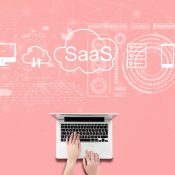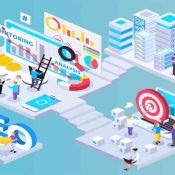
SaaS Statistics and Trends: Unveiling the Rapidly Evolving Landscape
The SaaS (Software as a Service) industry has grown remarkably, transforming how businesses operate and consume software solutions. As more companies embrace the cloud and adopt subscription-based models, the SaaS market continues to expand, disrupting traditional software paradigms and shaping the future of technology. This comprehensive blog delves into the latest SaaS statistics and trends, providing valuable insights into the industry’s evolution, adoption rates, pricing models, funding landscapes, and the benefits and challenges associated with this rapidly evolving sector.
What is SaaS, and how is it connected to industry, business, and companies?
Software as a Service (SaaS) is a distribution paradigm for software where programs are hosted and made available online, usually by subscription. Users access and use software through a web browser or specialized application rather than buying and installing it locally. The program and related data are stored on distant servers the SaaS provider manages.
SaaS solutions are extensively used in a wide range of businesses and industries, from start-ups to major corporations, and provide benefits like cost-effectiveness, scalability, accessibility, and lower maintenance costs. Businesses of all sizes use SaaS applications for various purposes, such as project management, customer relationship management (CRM), analytics, cooperation, and more.
SaaS Industry Growth
Increasing Adoption of Cloud Computing:
- The delivery and accessibility of software have been completely transformed by cloud computing.
- SaaS (Software as a Service) leverages cloud infrastructure to provide on-demand access to software applications over the Internet.
- This eliminates traditional software installation and maintenance, making it more convenient and cost-effective for businesses.
Proliferation of Mobile Devices:
- The widespread use of smartphones and tablets has fueled the demand for software solutions that are accessible on the go.
- SaaS apps are perfect for mobile consumers because they are made to work with a wide range of devices and operating systems.
- This accessibility has contributed to the rapid adoption of SaaS across various industries and user demographics.
Demand for Flexible and Scalable Solutions:
- Businesses today require software solutions that can adapt to their evolving needs and scale with their growth.
- SaaS platforms offer flexible subscription models, allowing businesses to easily adjust their usage and scale up or down as needed.
- This flexibility enables organizations to manage their resources and optimize their software investments.
Cost-Effectiveness of SaaS:
- SaaS eliminates the need for upfront capital investment in hardware and software licenses.
- Instead, businesses pay a subscription fee for software access, typically including maintenance, updates, and support.
- This pay-as-you-go model lowers the barrier to entry for smaller businesses and startups, making advanced software solutions more accessible.
Projected Market Growth:
- Leading research and consultancy firm Gartner states that the worldwide SaaS industry is expected to increase significantly.
- The market is expected to increase at a compound annual growth rate (CAGR) of 16.8% from 2021 to 2026, or $176.6 billion.
- This strong growth forecast reflects the industry’s growing reliance on SaaS solutions and the sector’s ongoing innovation.
SaaS Usage and Adoption
SaaS adoption has been steadily increasing across industries and company sizes as businesses recognize the benefits of this delivery model. According to a survey by BetterCloud, the average company uses about 80 SaaS applications, with larger enterprises using over 200 different SaaS solutions. Additionally, the COVID-19 pandemic accelerated the adoption of SaaS solutions as businesses pivoted to remote work and sought cloud-based management tools to facilitate collaboration and productivity.
SaaS Company Metrics
Monthly Recurring Revenue (MRR):
- As the consistent, repeating income from active subscribers that SaaS companies generate each month, MRR is an important measure.
- It provides insights into the company’s current revenue stream and helps forecast future revenue growth.
- Monitoring MRR allows SaaS companies to track the success of their subscription-based business model and identify trends in revenue generation over time.
Annual Recurring Revenue (ARR):
- ARR is another essential metric reflecting the annual recurring revenue generated from active subscriptions.
- ARR provides a broader perspective on revenue performance than MRR, considering the entire year’s revenue from subscriptions.
- SaaS companies often use ARR to assess their financial stability, measure growth, and evaluate the long-term value of their customer base.
Customer Acquisition Cost (CAC):
- CAC measures the cost of acquiring a new customer, including marketing, sales, and related expenses.
- It helps SaaS companies evaluate the efficiency and effectiveness of their sales and marketing efforts.
- By comparing CAC to customer lifetime value (LTV), companies can determine the sustainability of their customer acquisition strategies and optimize their spending to maximize profitability.
Customer Lifetime Value (LTV):
- A customer’s lifetime value (LTV) is the estimated revenue that the SaaS company anticipates receiving from them.
- Businesses may comprehend the long-term worth of obtaining and keeping customers by calculating LTV.
- While lower LTV may suggest the need to modify price and product offerings or enhance client retention methods, higher LTV indicates strong customer loyalty.
Churn Rate:
- The churn rate is the percentage of customers who cancel or forget to renew their subscriptions within a specified time frame.
- It is an essential indicator of client happiness, loyalty, and general company health.
- High turnover rates can indicate problems with customer service, competitive challenges, or product-market fit, identifying areas that need improvement to lower customer attrition and boost revenue stability.
SaaS Pricing Statistics
SaaS pricing structures have changed to accommodate a range of consumer and commercial demands. Although flat-rate pricing is still a common choice, many SaaS businesses are switching to more adaptable and scalable pricing models. Based on an OpenView poll, the most popular pricing schemes used by SaaS providers are:
Tiered Pricing:
- A common pricing strategy SaaS companies use is tiered pricing, which provides many packages or tiers with differing features and price points.
- This model offers flexibility and customization by letting clients select a bundle that best suits their requirements and financial situation.
- Generally speaking, tiered pricing offers basic, standard, and premium tiers with progressively higher levels of functionality and support in line with the scope and complexity of consumers’ needs.
- Tiered pricing helps SaaS organizations reach a wider customer base and increase revenue through chances for cross- and up-selling.
Usage-Based Pricing:
- Customers who employ usage-based pricing are billed according to usage metrics, like the quantity of data stored, the number of users, or API calls.
- This model allows for scalability and transparency because users only pay for the resources they use.
- Usage-based pricing greatly benefits businesses with varying consumption patterns or seasonal demands. It enables them to match expenses to actual usage.
- This paradigm allows SaaS organizations to attract clients with different requirements and consumption patterns and encourages effective resource management.
Flat-Rate Pricing:
- Flat-rate pricing offers a straightforward subscription fee, typically monthly or annual, regardless of usage or feature set.
- This model simplifies pricing and billing for customers, providing predictability and ease of budgeting.
- SaaS companies may opt for flat-rate pricing to appeal to customers who prefer simplicity and value clarity.
- However, this model may need to be revised to maximize revenue from high-value customers or accommodate diverse usage patterns compared to tiered or usage-based models.
Freemium Model:
- Under the freemium model, a basic version of the program is provided for free, with the option to upgrade to premium plans for additional features or functionality.
- It serves as a powerful marketing and customer acquisition strategy, allowing SaaS companies to attract a large user base with a low barrier to entry.
- Freemium models encourage users to experience the product firsthand before committing to a paid subscription, fostering trust and loyalty.
- SaaS companies leverage freemium offerings to drive user engagement, gather feedback, and upsell premium features to customers who require more advanced capabilities.
Funding of SaaS Companies
Seed Funding:
- The first round of funding for SaaS enterprises is known as seed money, and it is usually given by venture capital companies, angel investors, or accelerators.
- SaaS startups need this capital to construct their minimal viable product (MVP), validate the market, and start early client acquisition activities.
- Depending on the demands and development potential of the firm, seed capital rounds often vary from tens of thousands to a few million dollars.
Venture Capital (VC) Funding:
- Larger investment rounds provided by venture capital facilitate the expansion of SaaS companies’ operations and market reach.
- Series A, Series B, and later stages of a SaaS company’s development are common times for Venture Capital (VC) funding rounds.
- These funding rounds, which can total several million to hundreds of millions of dollars, allow SaaS companies to invest in infrastructure growth, sales and marketing, and product development.
Private Equity (PE) Investment:
- As SaaS companies mature and demonstrate strong revenue growth and profitability, they may attract private equity investment.
- Private equity(PE) firms provide capital in exchange for equity ownership in established SaaS companies. They focus on driving operational efficiency and maximizing returns.
- PE investment allows SaaS companies to pursue strategic initiatives such as acquisitions, international expansion, and product diversification to solidify their market position further.
Debt Financing:
- SaaS companies may also supplement equity funding with debt financing options such as bank loans, lines of credit, or revenue-based financing.
- Debt financing provides access to additional capital without diluting ownership stakes, offering flexibility in managing cash flow and growth initiatives.
- SaaS companies may leverage debt financing to fund specific projects, bridge gaps between funding rounds, or support expansion efforts while maintaining financial discipline.
Initial Public Offering (IPO):
- Going public through an IPO represents a significant milestone for successful SaaS companies, allowing them to raise substantial capital from public investors.
- IPOs provide liquidity for early investors and employees, enhance visibility and credibility in the market, and enable SaaS companies to access additional capital for further growth and acquisitions.
- However, the Initial Public Offering(IPO) process involves rigorous regulatory requirements, increased shareholder scrutiny, and potential market volatility, requiring careful consideration and preparation by SaaS companies.
Strategic Partnerships and Corporate Investments:
- SaaS enterprises can also obtain capital through corporate investments from market leaders or strategic alliances with well-established IT corporations.
- Strategic collaborations can speed up growth and market penetration for SaaS firms by giving them access to resources, knowledge, and distribution channels.
- Corporate investments promote innovation and cooperation in the SaaS ecosystem by giving SaaS startups access to capital, industry expertise, and possible synergies with strategic investors.
SaaS Stats from Countries Other Than the US
While the United States is a major hub for SaaS companies, the industry has a global footprint, with significant growth and adoption occurring in various regions worldwide. For instance:
Europe:
The European SaaS industry is expected to reach $63.4 billion by 2025, with Germany and the United Kingdom being the two largest markets, according to Statista.
Asia-Pacific:
The Asia-Pacific SaaS market is expected to develop at a compound annual growth rate (CAGR) of 27.8% between 2021 and 2027, driven by initiatives for digital transformation and increased cloud usage in countries like China, India, and Japan.
Latin America:
The Latin American SaaS market is projected to reach $6.7 billion by 2025. Brazil is the largest market, accounting for over 40% of the region’s SaaS revenue.
The Benefits of SaaS
The rapid growth and adoption of SaaS solutions can be attributed to numerous benefits offered by this delivery model, including:
Cost Efficiency:
SaaS solutions are generally more inexpensive for companies of all sizes due to their predictable subscription-based pricing and reduced upfront costs.
Scalability:
SaaS apps offer flexibility and agility as they can be readily scaled up or down in response to shifting business requirements.
Accessibility:
SaaS solutions allow users to work remotely and collaborate with others from any location by enabling software access and usage from any internet-connected device.
Automatic Updates:
SaaS companies handle all software maintenance and upgrades, guaranteeing that customers can always access the latest features and security fixes.
Reduced IT Overhead:
Businesses can reduce their IT infrastructure and resource requirements by outsourcing application hosting and maintenance to the SaaS provider.
The Limitations of SaaS
Although SaaS has many benefits, there are several restrictions that companies should be aware of:
Internet Dependence:
SaaS solutions require a stable internet connection, which can be challenging in areas with poor connectivity or during outages.
Data Security Concerns:
Even if SaaS providers use strong security protocols, some companies could be worried about data privacy and the dangers of keeping sensitive data on unaffiliated servers.
Integration Challenges:
Integrating different SaaS solutions with preexisting on-premises systems or other cloud apps can be challenging and might require more resources or customisation.
Vendor Lock-In:
Switching from one SaaS provider to another can be difficult due to data migration challenges and compatibility issues, potentially leading to vendor lock-in.
Customization Limitations:
SaaS solutions are usually designed to accommodate a large number of users, which could restrict the amount of customisation that can be done to suit particular business needs.
Difference Between Before and After SaaS Adoption
Some key points highlighting the differences between before and after adopting Software as a Service (SaaS) solutions:
Before SaaS Adoption:
On-premises software installation:
Companies had to install software applications on their servers and computers within their premises.
High upfront costs:
Purchasing software licenses, hardware infrastructure, and maintenance costs were significant upfront investments.
Lengthy implementation cycles:
Setting up on-premises software could take months or even years, delaying deployment and adoption.
In-house IT resources:
Companies require dedicated IT staff for software installation, updates, maintenance, and troubleshooting.
Limited scalability:
Scaling up or down required purchasing additional licenses and hardware, which was costly and time-consuming.
Compatibility issues:
Keeping software versions and hardware configurations compatible across the organization was a challenge.
Data security concerns:
Companies were solely responsible for securing their data and systems from potential threats.
After SaaS Adoption:
Cloud-based delivery:
SaaS apps don’t require on-premises installation because they are hosted and distributed online.
Subscription-based pricing:
Companies pay a recurring subscription fee, typically monthly or annually, reducing upfront costs.
Rapid deployment:
SaaS solutions can be deployed and accessed quickly, often within days or weeks.
Reduced IT overhead:
SaaS providers handle software updates, maintenance, and technical support, reducing the IT burden on companies.
Scalability on-demand:
Businesses can quickly adjust their resource and use levels to meet shifting demands.
Automatic updates:
Software upgrades and updates are handled by SaaS providers, guaranteeing that customers always have access to the newest version.
Improved accessibility:
Because SaaS programs are accessible from any location with an internet connection, they facilitate remote work and collaboration.
Shared responsibility for security:
SaaS providers implement robust security measures, sharing the responsibility for data protection with customers. Complementing these with reliable software maintenance services further strengthens data security, providing continuous monitoring and compliance support.
Integration capabilities:
SaaS solutions often offer integration options with other cloud-based applications and services.
Predictable costs:
SaaS subscriptions provide a predictable and operational expense model, making budgeting easier.
FAQs
What distinguishes on-premises software from Software as a Service (SaaS)?
SaaS (Software as a Service) apps are hosted in the cloud and accessed online, usually on a subscription basis. Still, on-premises software is installed and deployed locally on servers or workstations within an organization’s infrastructure.
How does the pricing of SaaS solutions work?
SaaS pricing models vary, but common approaches include flat-rate pricing (fixed monthly or annual fee), tiered pricing (different pricing levels based on features or usage), usage-based pricing (charged based on metrics like number of users or data storage), and freemium models (basic free version with paid premium plans).
What are the main drivers behind the growth of the SaaS industry?
A few main forces behind this trend are the growing popularity of cloud computing, the spread of mobile devices, the need for scalable and adaptable software, and the SaaS model’s lower costs and less IT overhead.
When employing SaaS solutions, how can businesses guarantee data security and compliance?
Businesses should thoroughly evaluate SaaS providers’ security measures and compliance certifications, implement robust access controls and data encryption, and establish clear data governance policies and procedures. Regular security audits and risk assessments are also recommended.
What are the primary obstacles that SaaS companies must overcome?
Common challenges include increasing competition, customer retention, minimizing churn, ensuring data privacy and security, seamless integration and interoperability between SaaS solutions, and maintaining scalability and performance as customer bases grow.
How does the adoption of SaaS solutions impact IT departments and roles?
The shift to SaaS solutions often reduces the need for on-premises IT infrastructure and resources. IT roles may transition from traditional system administration to focus more on cloud management, integration, and ensuring seamless access and collaboration across different SaaS applications.
Conclusion
The SaaS industry has experienced remarkable growth and disruption, transforming how businesses acquire, deploy, and utilize software solutions. As the statistics and trends presented in this blog post demonstrate, the adoption of SaaS continues to accelerate, driven by the compelling benefits of cost-efficiency, scalability, accessibility and reduced IT overhead.
However, the SaaS landscape has challenges, including increasing competition, customer retention, data security concerns, integration complexities, and the need for continuous innovation to meet evolving business demands.




